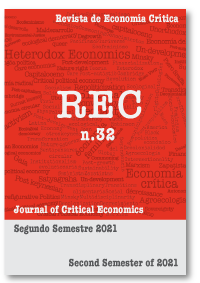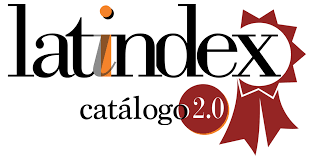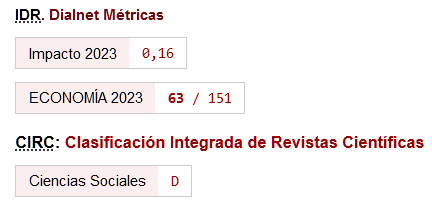La intensidad del trabajo desde la teoría marxista, una propuesta de medición alternativa.
DOI:
https://doi.org/10.46661/rec.10232Palabras clave:
gasto de fuerza humana de trabajo e intensidad laboralResumen
A partir del concepto marxista de gasto de fuerza humana de trabajo se plantea una forma novedosa de expresar de la condensación de trabajo en un espacio de tiempo, con la cual se propone un método de medición alternativo de la intensidad del trabajo.Descargas
Citas
Astarita, R. (2011). Economía política de la dependencia y el subdesarrollo: tipo de cambio y renta agraria en la Argentina. Buenos Aires: Universidad Nacional de Quilmes.
Askenazy, P. (2004). Shorter work time, hours flexibility, and labor intensification. Eastern Economic Journal, 30(4), pp. 603-614.
Barford, N. C. (1985). Experimental measurements: precision. Error and Truth. Chichester: Wiley, 2a edición.
Bennett, A., y Smith-Gavine, S. (1987). The percentage utilisation of labour index (PUL). In Working Below Capacity, pp. 326-363. Palgrave Macmillan, London. https://doi.org/10.1007/978-1-349-08649-8_12 DOI: https://doi.org/10.1007/978-1-349-08649-8_12
Burchell, B. (2002). The prevalence and redistribution of job insecurity and work intensification. Job insecurity and work intensification, pp. 61-76. https://doi.org/10.4324/9780203996881 DOI: https://doi.org/10.4324/9780203996881
Burke, R. J., Singh, P., y Fiksenbaum, L. (2010). Work intensity: potential antecedents and consequences. Personnel Review. https://doi.org/10.1108/00483481011030539 DOI: https://doi.org/10.1108/00483481011030539
Burke, R. J., Koyuncu, M., Fiksenbaum, L., y Acar, F. T. (2009). Work hours, work intensity, satisfactions and psychological well-being among Turkish manufacturing managers. Europe's Journal of Psychology, 5(2), pp. 12-30. https://doi.org/10.5964/ejop.v5i2.264 DOI: https://doi.org/10.5964/ejop.v5i2.264
Burkett, P., y Foster, J. B. (2006). Metabolism, energy, and entropy in Marx's critique of political economy: Beyond the Podolinsky myth. Theory and Society, 35(1), pp. 109-156. https://doi.org/10.1007/s11186-006-6781-2 DOI: https://doi.org/10.1007/s11186-006-6781-2
Braverman, H. (1998). Labor and monopoly capital: The degradation of work in the twentieth century. NYU Press.
Chapman, S. J. (1909). Hours of labour. The Economic Journal, 19(75), pp. 353-373.
https://doi.org/10.2307/2221102 DOI: https://doi.org/10.2307/2221102
Dussel, E. (1985). La producción teórica de Marx, un comentario a los Grundrisse. México, Ed. Siglo XXI, 1863-1882.
Foster, J. B., y Burkett, P. (2008). The Podolinsky Myth: An Obituary Introduction to 'Human Labour and Unity of Force', by Sergei Podolinsky. Historical Materialism, 16(1), pp. 115-161.
https://doi.org/10.1163/156920608X276323 DOI: https://doi.org/10.1163/156920608X276323
Fairris, D., y Alston, L. J. (1994). Wages and the intensity of labor effort: Efficiency wages versus compensating payments. Southern Economic Journal, pp. 149-160. https://doi.org/10.2307/1060136 DOI: https://doi.org/10.2307/1060136
Green, F. (2001). It's been a hard day's night: the concentration and intensification of work in late twentieth‐century Britain. British Journal of Industrial Relations, 39(1), pp. 53-80.
https://doi.org/10.1111/1467-8543.00189 DOI: https://doi.org/10.1111/1467-8543.00189
Hernández. S. A. Sebastián, y Deytha, M. Alan A. (2018). Profit Maximization Problem in Marxist Perspective. Marxism 21, 15(4), pp. 142-181.
Hernández, S. A. Sebastián, y Deytha, M. Alan A. (2020). Work Intensity and Value Formation: A Suggested Interpretation. Science & Society, 84(2), pp. 261-275. https://doi.org/10.1521/siso.2020.84.2.261 DOI: https://doi.org/10.1521/siso.2020.84.2.261
Hsie, M., Hsiao, W. T., Cheng, T. M., y Chen, H. C. (2009). A model used in creating a work-rest schedule for laborers. Automation in Construction, 18(6), pp. 762-769. https://doi.org/10.1016/j.autcon.2009.02.010 DOI: https://doi.org/10.1016/j.autcon.2009.02.010
Ioannides, A., y Mavroudeas, S. (2010). Work more or work harder? The duration and intensity of work in Marx's Capital. Science & Society, 74(1), pp. 85-102. https://doi.org/10.1521/siso.2010.74.1.85 DOI: https://doi.org/10.1521/siso.2010.74.1.85
Kohont, A., y Zajc, J. Č. (2019). Relationship between high work intensity, organisational performance and workers' health: a focus on workers is reflected in better health. Teorija in Praksa, 56(4), pp. 1189-1203.
Mavroudeas, S., y Ioannides, A. (2010). Duration, intensity and productivity of labour and the distinction between absolute and relative surplus-value. Review of Political Economy, 23(3), pp. 421-437. https://doi.org/10.1080/09538259.2011.583833 DOI: https://doi.org/10.1080/09538259.2011.583833
Mavroudeas, S., y Ioannides, A. (2011). A model for the relationship between working time and the intensity of labour. Bulletin of Political Economy, 5(2), pp. 111-127.
Gareth, J., Daniela, W., Trevor, H., y Robert, T. (2013). An introduction to statistical learning: with applications in R. Spinger.
Khanade, K., y Sasangohar, F. (2017, septiembre). Stress, fatigue, and workload in intensive care nursing: a scoping literature review. In Proceedings of the Human Factors and Ergonomics Society Annual Meeting, Vol. 61, No. 1, pp. 686-690. Sage CA: Los Angeles, CA: SAGE Publications.
https://doi.org/10.1177/1541931213601658 DOI: https://doi.org/10.1177/1541931213601658
Ma, W., Shao, W., y Ji, X. (2018). Dynamic work hour optimization for casual workers. Journal of Combinatorial Optimization, 35(4), pp. 1185-1201. https://doi.org/10.1007/s10878-018-0263-0 DOI: https://doi.org/10.1007/s10878-018-0263-0
Marx, K. (1975). El Capital. Crítica de la Economía Política. Tomo I. El Proceso de Producción de Capital. Vol. 1, 2 y 3.
Marx, K. y Engels, F. (s.f.), Correspondencia, Ediciones Política, La Habana.
Petersen, S. R., Anderson, G. S., Tipton, M. J., Docherty, D., Graham, T. E., Sharkey, B. J., y Taylor, N. A. (2016). Towards best practice in physical and physiological employment standards. Applied Physiology, Nutrition, and Metabolism, 41(6), S47-S62. https://doi.org/10.1139/apnm-2016-0003 DOI: https://doi.org/10.1139/apnm-2016-0003
Piasna, A. (2018). Scheduled to work hard: The relationship between non‐standard working hours and work intensity among European workers (2005-2015). Human Resource Management Journal, 28(1), pp. 167-181. https://doi.org/10.1111/1748-8583.12171 DOI: https://doi.org/10.1111/1748-8583.12171
Osgnach, C., Poser, S., Bernardini, R., Rinaldo, R., y Di Prampero, P. E. (2010). Energy cost and metabolic power in elite soccer: a new match analysis approach. Med Sci Sports Exerc, 42(1), pp. 170-178. https://doi.org/10.1249/MSS.0b013e3181ae5cfd DOI: https://doi.org/10.1249/MSS.0b013e3181ae5cfd
Saad-Filho, A. (1993). A Note on Marx's Analysis of the Composition of Capital. Capital & Class, 17(2), pp. 127-146. https://doi.org/10.1177/030981689305000106 DOI: https://doi.org/10.1177/030981689305000106
Slatten, L. A., Carson, K. D., y Carson, P. P. (2011). Compassion fatigue and burnout: What managers should know. The Health Care Manager, 30(4), pp. 325-333. https://doi.org/10.1097/HCM.0b013e31823511f7 DOI: https://doi.org/10.1097/HCM.0b013e31823511f7
Vandersmissen, G. J. M., Verhoogen, R. A. J. R., Van Cauwenbergh, A. F. M., y Godderis, L. (2014). Determinants of maximal oxygen uptake (VO2 max) in fire fighter testing. Applied ergonomics, 45(4), pp. 1063-1066. https://doi.org/10.1016/j.apergo.2014.01.001 DOI: https://doi.org/10.1016/j.apergo.2014.01.001
Wu, H. C., y Wang, M. J. J. (2001). Determining the maximum acceptable work duration for high-intensity work. European journal of applied physiology, 85(3-4), pp. 339-344.
https://doi.org/10.1007/s004210100453 DOI: https://doi.org/10.1007/s004210100453
Zou, H., y Hastie, T. (2005). Regularization and variable selection via the elastic net. Journal of the royal statistical society: series B (statistical methodology), 67(2), pp. 301-320. https://doi.org/10.1111/j.1467-9868.2005.00503.x DOI: https://doi.org/10.1111/j.1467-9868.2005.00503.x
Descargas
Publicado
Cómo citar
Número
Sección
Licencia
Derechos de autor 2021 Alan A. Deytha Mon, A. Sebastián Hdez. Solorza

Esta obra está bajo una licencia internacional Creative Commons Atribución 4.0.
Esta licencia permite a terceros compartir (copiar y redistribuir el material en cualquier medio o formato) y adaptar (remezclar, transformar y crear a partir del material para cualquier finalidad, incluso comercial), siempre que se reconozca la autoría y la primera publicación en esta revista (La Revista, DOI de la obra), se proporcione un enlace a la licencia y se indique si se han realizado cambios en la obra.







